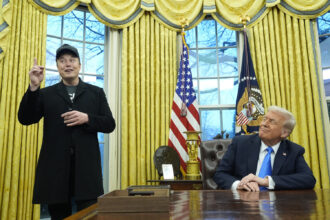Klaus Vedfelt | Digitalvision | Getty Images
As rounds of layoffs continue within a historically strong stock market and resilient economy, it is still uncommon for companies to link job cuts directly to AI replacement technology.
IBM was an outlier when its CEO told the Wall Street Journal in May that 200 HR employees were let go and replaced with AI chatbots, while also stating that the company’s overall headcount is up as it reinvests elsewhere.
Fintech company Klarna has been among the most transparent in discussing how AI is transforming – and shrinking – its workforce. “The truth is, the company has shrunk from about 5,000 to now almost 3,000 employees,” Klarna CEO Sebastian Siemiatkowski told CNBC’s “Power Lunch” in May. “If you go to LinkedIn and look at the jobs, you’ll see how we’re shrinking.”
But employment experts suspect that IBM and Klarna are not alone in AI-related purges. It’s just that firms often limit their explanations to terms like reorganization, restructuring, and optimization, and that terminology could be AI in disguise.
“What we’re likely seeing is AI-driven workforce reshaping, without the public acknowledgment,” said Christine Inge, an instructor of professional and executive development at Harvard University. “Very few organizations are willing to say, ‘We’re replacing people with AI,’ even when that’s effectively what’s happening.”
“Many companies are relying on these euphemisms as a shield,” said Jason Leverant, chief operating officer and president of AtWork Group, a national staffing franchise that provides over 40,000 workers to companies across a variety of sectors. Leverant says it is much easier to frame workforce reductions as a component of a broader operational strategy than admitting that they are tied directly to efficiencies found as a result of AI implementation. “Companies laying off as they embrace large-scale AI adoption is much too coincidental to ignore,” Leverant said.
Candice Scarborough, director of cybersecurity and software engineering at Parsons Corporation, said it is clear from recent strong earnings that layoffs are not a response to financial struggles. “They align suspiciously well with the rollout of large AI systems. That suggests that jobs are being eliminated after AI tools are introduced, not before,” Scarborough said.
She added that the use of vaguer terms can be better messaging. Restructuring sounds proactive; business optimization sounds strategic; and a focus on cost structures feels impartial. “But the result is often the same: displacement by software. Sandbagging these cuts under bland language helps companies avoid ‘AI backlash’ while still moving ahead with automation,” Scarborough said.

Many companies are cutting roles in content, operations, customer service, and HR — functions where generative AI and agentic tools are increasingly capable — while messaging the corporate decisions as “efficiency” moves despite healthy balance sheets.
“This silence is strategic,” Inge said. “Being explicit about AI displacement invites blowback from employees, the public, and even regulators. Staying vague helps preserve morale and manage optics during the transition behind the scenes.”
Messaging a risky artificial intelligence labor shift
Inge and other experts say there is also a measure of risk management in decisions to de-emphasize AI in job elimination. Even companies eager to leverage AI to replace workers often realize they overestimated what the technology can do.
“There’s absolutely an AI undercurrent behind many of today’s ‘efficiency’ layoffs, especially in back-office and customer service roles,” said Taylor Goucher, vice president of sales and marketing at Connext Global, an IT outsourcing firm. Companies are investing heavily in automation, Goucher says, but companies are sometimes forced to backpedal.
“AI might automate 70%–90% of a process, but the last mile still needs the human touch, especially for QA, judgment calls, and edge cases,” Goucher said.
Sticking to a hybrid model of human plus AI would make more sense for the early adoption phase, but once the jobs are gone, companies are more likely to turn to third-party hiring firms or overseas markets before any U.S.-based jobs come back. “When the AI doesn’t work out, they quietly outsource or rehire globally to bridge the gap,” Goucher said.
Most firms will limit information about these labor market strategic shifts.
“They fear backlash from employees, customers, and investors skeptical of half-baked AI promises,” Goucher said. Many companies tout their AI strategy publicly, while quietly hiring skilled offshore teams to handle what AI can’t, he added. “It’s a strategy, but not always a complete one. Leaders need to be more honest about where AI adds value, and where human expertise is still irreplaceable,” he said.
Inge agrees that while AI can do a lot, it can’t replace a whole human, yet.
“AI can do a lot of things 90%. AI writes better ad copy, but human judgment is still required. That 10% where human judgment is needed, we are not going to see that replaced in the near term. Some companies are getting rid of 100% of it, but it will come back to bite them,” Inge said.
Mike Sinoway, CEO of San Francisco software company LucidWorks, said the limitations with current AI — and a more pervasive lack of certainty in the C-suite about adoption — are reasons to believe AI has not been directly responsible for many layoffs yet. Rather than ducking the issue of where AI is already replacing workers, Sinoway said his firm’s research suggests “higher-ups are panicking because their AI efforts aren’t panning out.”
The first to be told AI took their jobs: 1099 workers
Starting two to three years ago, freelancers were among the first employees that companies were direct with in discussing AI’s role in job cuts.
“Often, they are being told they are being replaced with an AI tool,” Inge said. “People are willing to say that to a 1099 person,” she added.
Copywriting, graphic design, and video editing have borne the brunt of the changes, according to Inge, and now the labor shift has begun to work its way into the full-time force. Inge says that transparency is the best policy, but that may not be enough. She pointed to the backlash that language learning company Duolingo faced when CEO Luis von Ahn announced plans earlier this year to phase out contractors in favor of AI, and then was forced to walk back some of his comments.
“After the huge backlash that Duolingo faced, companies are afraid to say that is what they are doing. People are going to get angry that AI is replacing jobs,” Inge said.
For now, the job market is solid, if showing some signs of softening in the first half of the year. The U.S. unemployment rate fell to 4.1% in June 2025, which according to Trading Economics, signals broad labor market stability. But there is also general agreement that over time, the pace of AI-linked job change will accelerate. According to the World Economic Forum’s 2025 Future of Jobs report, 41% of employers worldwide intend to reduce their workforce in the next five years due to AI automation. Anthropic CEO Dario Amodei recently predicted generative AI like his firm’s Claude large language model could wipe out up to half of entry-level officer worker jobs.
There will be a tipping point in the future when companies will be more uniformly transparent, but by that time, AI’s role in the labor market will be obvious.
“By then it won’t matter,” Inge said. “Job losses will be extremely large, the only thing we can do as individuals is adapt.”









